|
Colonet Volunteers Add Six Houses in 2005
A group of Episcopalians from Marin County
will construct the final house of 2005 when they travel to Colonet from June 16-23.
Under the leadership of veteran Jack Grimes, the team will be building Casa #29 (the sixth of year 2005) on the hill
just south of town.
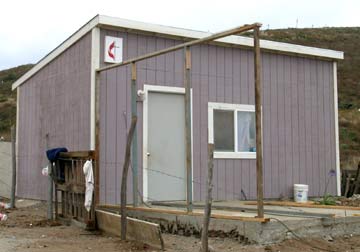
|
| Casa 25 built by Paradise UMC |
Four houses were built during Easter and Spring breaks by groups which included a large number
of youngsters who were enjoying a week’s respite from their academic grind. Teams
from Paradise UMC and Trinity UMC of Chico each built a house during the period March 19-23. The Chico house was built just north of the bridge across the dry river
bed, while the Paradise home was built in the hills several blocks south of the kindergarten
built several years ago.
The usual large contingent from Los Gatos UMC built two houses during its week in Colonet (April 10-14). This raised the number of houses erected by Los Gatos
crews to 11! Both of their homes were constructed on a single parcel in the hills
that rise above Highway One, just east of the bridge. Their homes were built
for a grandmother, daughter and grand-daughter.

|
| Crowds of racing fans lining Mexican Highway One |
The fifth house was added during the second week of June by a small group (six volunteers) from Foothills UMC in Cameron Park. The highlight of this group’s visit was the fact that their arrival in Mexico
coincided with the running of the Baja 500—a road race that starts in Ensenada
and runs down the coast past Colonet. Most of the race is off-road, but believe
it or not, much of it takes place on the narrow paved strip that is Mexican Highway One, and most significantly: They do not close off Mexican Highway One during the race! This means that a safe and sane tourist might find himself
being passed on the left or right (or sometimes both) by groups of maniacal racers on motorcycles, atvs, and supercharged
dune buggies. Fred Arth of Foothills UMC (driving his own super-charged Nissan
Frontier SUV) actually found himself among the race leaders near San Vicente, but wisely decided to abandon the race in favor
of the building project at San Telmo).
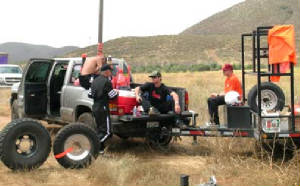
|
| Pit crews awaiting the arrival of their dune buggy |
During the race, sections of the highway from Santo Tomas to San Vicente are lined with thousands
of local residents and hundreds of pit crew volunteers who are carrying extra tires and gas for those vehicles involved in
the race.
All of this year’s houses were the larger version with loft, as all of the recipients were single mothers with
one or more children. Several of the groups also involved themselves in other
projects, such as making repairs at the local Iglesia Metodista and making some improvements in the community park at the
town center.
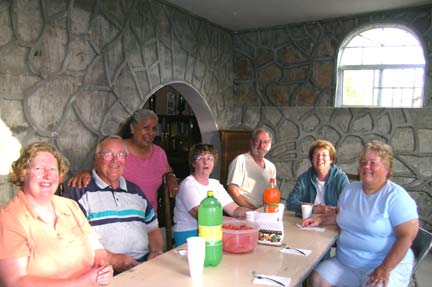
|
| The First Supper in Frances' new dining room |
Another major project involved helping Frances
Jackson put the finishing touches on the dining room adjacent to her kitchen, which was finally completed only 25 years after
she started! Future volunteer groups will now be able to dine in style at her
house rather than at the more austere school kitchen. The gentleman who did the
finish work on her walls was a genuine artist who added some splendid designs and texture to the existing rock and concrete
walls.
Most of the construction
of the 12’ x 20’ homes has undergone few changes since the inception of the program, but Foothill has decided
that each of the homes should have a water supply, so they have financed the addition of an elevated cistern at both the house
they built in 2004 as well as at this year's effort in San Telmo (the small community on the other side of the PEMEX
station, about eight miles south of Colonet). Cost of the cistern and its
concrete stand is about $350, and it enables a family to have a steady source of water (either from the local mains when they
are operational or from truck deliveries if there is no piped source available).
Speaking of costs, the price of building materials has
risen substantially in the past two years, and the cost of building a 240-square foot house is now about $3200, including
the following:
Cement Slab
and Plumbing Parts
$ 390
Lumber and
shingles from Ensenada $1900
Doors from
U.S.
$ 200
Windows
from Colonet manufacturer $ 200
Plumbing
Supplies
$ 300
Electrical
Supplies
$ 60
Miscellaneous
$ 100
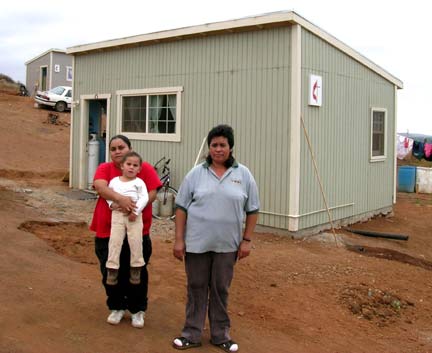
|
| Casas 26 and 27 constructed by teams from Los Gatos UMC |

|
| The 10-unit Senior Housing Complex in Colonet |
Colonet: Celebrating Christmas and Preparing for 2005
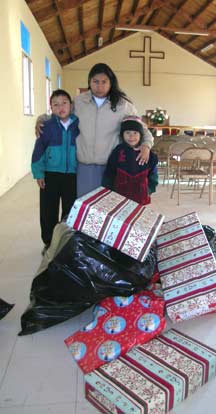

We made our annual December trek to Colonet during the first week of December to deliver presents
to the local Iglesia Metodista as well as to Frances Jackson. In other years,
the church has held a small Christmas party for the kids in the congregation as well as in the surrounding area, while Frances
usually distributes the presents at the “Kindergarten on the Hill” (built by one of the VIM groups in June 2003)
as well as to some of the younger kids at the Indian school (for which the kitchen was built in September 2002). These parties traditionally are held in mid-December, so the goal was to make sure the presents were on
hand as early as possible.
Special
thanks are in order to Paradise and Durham UMCs for their donations, and particularly to Betty Peters of Trinity Chico who
single-handedly contributed dozens of presents and nearly filled the truck with clothes, blankets and sleeping bags that Frances will pass out to local families trying to cope with the winter weather. (Heavy overnight frosts are common in the area south of Ensenada).
We are currently
laying plans for the 2005 building program. While we were hoping that a local
grower would contribute another parcel for a second 10-plex, that has not been forthcoming.
However, Frances has had a number of requests for individual homes from families who have
managed to acquire a piece of land in the past several years, but who have not been able to afford a house. Thus, the initial emphasis in 2005 will be on constructing individual homes. As of December, the only group with a confirmed date is Los Gatos
whose youth will celebrate Spring Break (April 11-15) by building a pair of 12 x 20 houses on slabs that will be poured in
the next couple of months. Frances
has a number of other candidates for other groups, as we continue to work toward the goal of obtaining land for another ten-unit
complex.
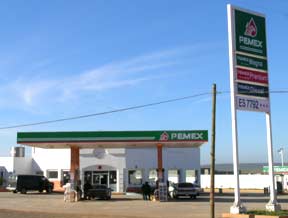
|
| The new PEMEX station |
Other groups that have indicated interest
so far include Trinity UMC Chico
(during Easter Vacation), Foothills UMC (possibly in June), St. John’s
Episcopal of Marin, and the Rotary Club of Marin. The estimated cost of constructing
a house in 2005 remains about $2500, which includes the slab, building materials purchased in Ensenada, donated windows, and
the various materials purchased in the U.S. (doors, plumbing, electrical and hardware).
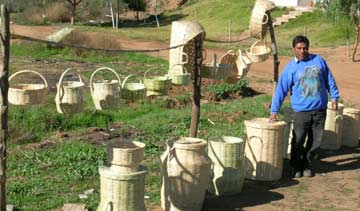
|
| Senor Arturo and his basket stand |
There usually are not a lot of changes in Colonet,
and this trip produced few surprises…..except for the fact that the year-old project to construct a PEMEX station in
downtown Colonet finally was completed! Also, there was some additional evidence
of entrepreneurial enterprise on the part of one Senor Arturo who has re-opened the basket concession a few miles east of
the Hotel Sonora Hilton. Speaking of which, the (formerly pink) motel now is painted a bright white and is sporting some elaborate decorations
for the Christmas season.
Questions
or comments: zeenut@sunset.net
Rotary Organizes Team To Finish Senior Complex
A combined team of
Methodists and Rotarians traveled to Colonet during the first week of August to finish the final four units in the ten-unit
Senior Citizens complex that was started during the 2004 Easter Break.
Colonet Veteran
Vic Baldridge recruited a team consisting largely of fellow Rotarians from Marin County who were scheduled to coordinate efforts
with members of the Club de Rotario in San Quintin. They were joined by
a handful of previous Methodist volunteers—three from Chico and two from the Foothills UMC team in Cameron Park that
helped build Casa XIX in mid-June.
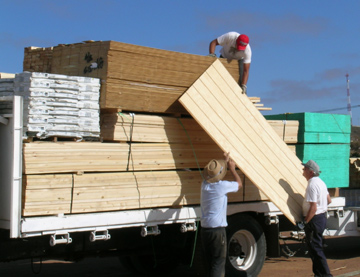
|
| Unloading the lumber from Ensenada |
The 13-member
team (which included four teen-agers) was able to complete most of the work in five days. The project got off to a slow
start, as the materials that were scheduled to arrive at noon on Friday, July 30 did not reach the site until after 6 p.m.
(Not for the first time!). The worse news was that our able associate
Ivan was working for the Americanos at the beach and so it took three less hardy VIM volunteers almost two hours to unload
the materials for the four houses to be constructed.
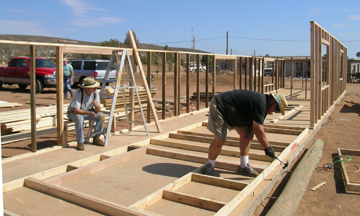
Work began Saturday morning, and by sunset most of the framing was completed. As with the first units of the 10-unit
complex, these homes do not contain separate bathrooms. (Two bathrooms and a shower are located at the end of the building
and are shared by the residents of all four units). Since all of the units in the complex are intended for senior citizens,
they are constructed with shorter (72" and 96") walls without a loft.
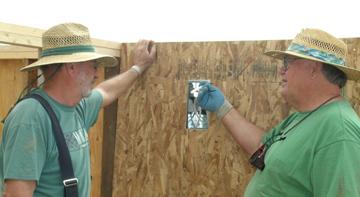
|
| Fred and Herman--The Senior Paneling Team |
Most of Sunday was devoted to interior and exterior paneling, which went fairly quickly, thanks to some diligent labor augmented
with a rapid-fire nailing gun. A large painting crew also was hard at work, pre-painting the 40 panels needed for the
roof, along with the 45 rafters and 84 blocks which support the panels.
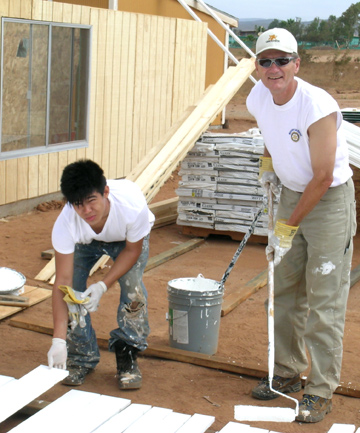
|
| Master Painters Katsuo and Bob |
By Monday, it was time to install the rafters and roofing panels in order to permit the shingling crew
to get an early start on Tuesday morning. Meanwhile, painting crews worked on the 60 pieces of exterior trim, painting
them a bright white to match the design on the six units that were completed last April. At the same time,
a team of electricians intalled plugs and lights in the four houses. (None of the units are expected to have electricity
for some months, as several poles need to be erected, as well as wires strung from the poles to individual homes. Apparently
this also involves a complicated inspection and approval process in which the local Rotary Club is expected to play the lead
role).
The rest of the week was devoted to installing the plumbing for the sinks in the individual units as well as the toilets and
shower at the end of the builidng. As with the electricity, it is not expected that units
will have water in the immediate future. Most of Colonet has water only two or three days in an average week, and the
area's water authority is refusing to approve any more hook-ups until the present supply is augmented. (During the summer,
most of the scarce water supplies are allocated to the local growers).
Team Leader Vic Baldridge was not willing to take no for an answer, however, and, working with members of the San Quintin
Rotary Club, organized a delegation to visit the area water officials in Colonia Vicente Guerrero. When they heard about the volunteer building project, the officials were sympathetic to the plight of the
ten water-less homeowners, and agreed to recommend issuance of water permits for the complex.
This has to be approved by even higher level officials in Ensenada, and another delegation was being dispatched to
that city to plead the case for a waiver from the water ban. (More later,
hopefully).
The Rotary team also decided to tackle the problem
of a septic system for the ten-unit complex. While they were in Colonia Vicente
Guerrero, delegation members presented the problem to the water officials who agreed to provide a back-hoe to dig the large
hole necessary for the purpose. The back-hoe started work later that afternoon,
and after a couple of false starts (and the provision of some pesos and beverages to a second back-hoe operator) the hole
was completed that day. After which the team passed the hat and raised the $700
that Ivan will need for the labor and materials to construct a concrete holding tank!
With a little water and a little concrete, who knows: Maybe the folks
at the Senior Complex will have working toilets sometime in the near future!
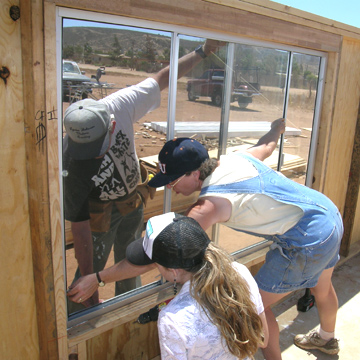
|
| Installing Windows in the Four-Plex |
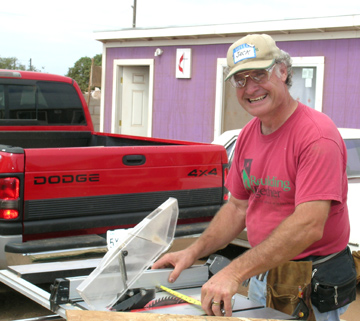
|
| Smilin' Jack on the Chop Saw |
Trip Report For Casa #19 Construction
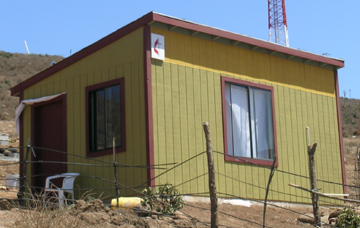
Judith Potor of Foothills UMC was the team leader of a group from Foothill UMC that constructed the 19th
home in June, 2004 and she authored the following trip report which should be of interest to any Colonet volunteer, past or
prospective:
"My experience
in Mexico was one of the most gratifying things I have ever done and the memories of this trip will remain with me for
the rest of my life. Seeing people who must live each day of their lives facing extreme poverty puts things in perspective.
I have returned to my home once again with a greater awareness of my many blessings - how very fortunate I am to live the
life I lead.
What
can I tell you about Mexico and my week in Colonet....
First of all, the village of Colonet is 600 miles from where I live, located in the coastal
desert of Baja, California - four hours below the California - U.S. border. Once I left the United States, I journeyed beside the ocean
on a fairly good road that took me to the resort town of Ensenada. I spent my first night in Ensenada before proceeding
across some low lying mountains to the south that would eventually lead me to Colonet. There was a soldier station with
armed guards that I had to pass in my car, but went through without incident.
The village of
Colonet is described as a small agricultural and ranching community. Crops grown in the area consist of tomatoes, celery,
onions, potatoes, and peppers. Many of the villagers work in the fields during the summer growing months. There is little
commercial development in Colonet and the only major industry involves the tomato processing plant that remains open only
five months of the year.
Most of the
villagers are poor and live in small houses made from wood, concrete block, or any other pieces of material that can provide
some type of shelter. I saw houses made out of tin sheets and those made from cardboard. The villagers, during
the growing season, work in the fields six days a week. On Sunday they often attend church services. Some
of the churches in the community consist of Roman Catholic, Pentecostal, and Methodist.
Within an
hour after arriving in Colonet on Saturday - the building project began. The concrete house slab had already been
poured and the framing had been begun by two men who had worked on similar projects before. One of these men was the organizer
for previous Colonet projects and had driven even farther than we had - to spend the next several days building Casa
#19. The other man (Ivan) was a young Mexican who spoke good English and was skilled with building.
We
arrived at the site to find its location less than desirable. The tiny lot was located on the side of a dusty hill
surrounded by desert plants and scrub. There were very few flat areas for working and it became a challenge to have
to constantly deal with things on a slant. The dust that flew during windy afternoons permeated everything and
caused coughing, sneezing, and dry, gritty eyes.
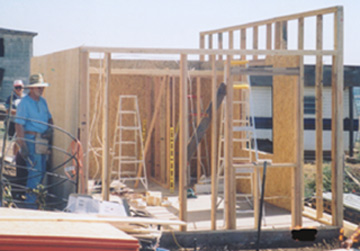
|
| First Day at the Job Site |
But the unfavorable conditions were tolerated by a group of people eager to build and work together. On that Saturday
afternoon we were able to put up the exterior walls, do some painting, and erect a roof. By Sunday morning the roof was sheeted
and work was begun inside of the 12 x 20 foot house. In the next day
a sleeping loft was added as well as windows and a kitchen - bathroom area. Tuesday and Wednesday had
our team doing finish work - plumbing, electrical, painting, molding, doors.
It is hard to believe that we were able to complete the house by Wednesday and that a small force of people,
with the average age of 64 years, could have a home ready for occupancy in 4 1/2 days. Because there was no water for
the household even though it was plumbed for water, our group decided to invest in a water holding tank that would provide
water for bathing, cleaning, and garden watering.
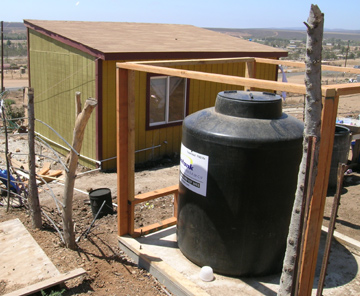
|
| Cistern installed above Casa 19 |
There is little water in Colonet
and the lack of water is a tremendous problem for local residents. To fill the water tank that would be installed costs
$10.00 which is quite a high price for a mother who earns so little money. It is the same with electricity. We
provided the wiring for electricity, but the cost of it each month prohibits most of the families we help from being able
to use it.
The family in which we served consisted
of a 38 year old abandoned mother, her five children, and one grandchild. Her husband had gone to the United States
and never returned. This lady works in the fields all day and has little money to feed her family - much less provide
them with basic shelter. While the house was being constructed, the family was eager to watch over the building site,
slept out on the side of the hill on pieces of cardboard that they had scrounged. They used an open fire for cooking
and had one pot in which to cook their food.

|
| Celebrating with the new homeowners! |
The woman and her family were eager to help after her day was completed working in the fields. As poor as she was, this
woman displayed a graciousness and generosity that overwhelmed and touched us. The evening that the house was completed,
we were invited to come to her home for dinner. Even though she had very little, this young mother wanted to thank us
by inviting us into her home. When we arrived at the little house we could hear beautiful singing and entered the home
only to find a gathering of people who were there to spiritually celebrate a blessing of the house.
The Pentecostal minister played
his guitar and we heard some beautiful Spanish hymns. By the end of the service there were few dry eyes.
It became particularly poignant when the mother of the household talked to us and expressed her appreciation for what
she called "the miracle" she had been given. Words cannot begin to express what that particular evening meant to me.
I was deeply moved by the sincerity and love of those who gathered together with us to express their gratitude.
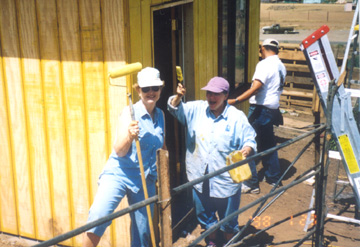
|
| Painters at Work? |
In fact, all week I felt "touched" by different people.
There was Francis Jackson - a Mexican "Mother Teresa" who helps in her Colonet community. It was Francis who acted as
our interpreter and took care of us each evening with wonderful food served in her home. She also arranged for us to
visit the local schools and distribute educational supplies. Francis is the matriarch of her community and advised
us on who needed assistance the most. She became invaluable at the local police station when we had to deal with
an automobile incident involving one of the drivers of our cars who had accidentally hit a young child.
Challenges came up while we were in Mexico and as leader
of the team I felt a large responsibility for the welfare of each and every person. However, through faith and working
closely together in team spirit- problems were solved. Each evening before bed - there would be short meetings
to discuss the days events and partake of spiritual food for thought. This became a very special time
because through people's discussions it became very obvious just how much the work we were doing was blessing us all.
There is a saying that states - "When you give - you receive" . I felt throughout my Colonet experience that
I was receiving far more than what I was giving.
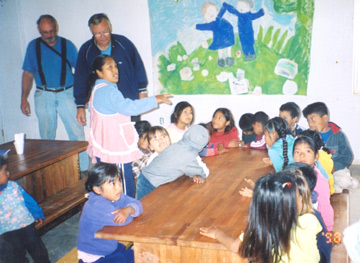
|
| 'Thank You' party at the kindergarten |
Other highlights of the week included several visits to schools. One morning our group of seven was invited
to visit a little one-room schoolhouse that had been built by a previous VIM team. The children and their parents were
so grateful for the school that we were treated to a wonderful breakfast prepared by some of the mothers of the school
children. We also got to play games with the kids and sing with them. At another school where VIM had
built a kitchen, the school children celebrated our visit by sharing with us some of their special dances.
On another occasion a man and his family arrived
at our building site one hot and dusty afternoon with bottles of water and soda for our group. He had seen us working
on the side of the hill and wanted to provide beverages for us since a previous VIM group had built a home for him and his
family (Martin Fuertes and family living in Casa XII). This man was very poor, he had already been provided with a home,
yet he still found the time and money to show his gratitude by giving something for us to drink on that warm, sunny
afternoon.
The week proceeded very quickly and it was soon time to leave Colonet.
We were left with so many precious memories and the desire to return to Colonet within the next year.
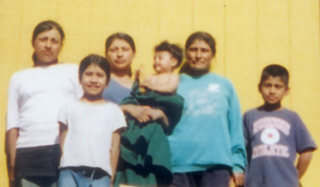
|
| The new homeowners |
Upon reflection
of my experience as team leader, I felt a seriousness of purpose and a responsibility that stretched me as a person.
I learned and grew from the challenges, while acquiring a feeling of capability and resourcefulness. It will
take me some time to "wind down" from the experience. When I returned home and looked at my lovely green yard
with its abundant vegetation, the ponds that are filled with fish, the woods where animals love to habitat - and
spent my first night home in my bed securely surrounded by a large, well built home that lacks for nothing
- I remember those in Colonet who don't even have water in which to drink or bathe and must live in the most
dire of circumstances. I look at my life once again and am extremely grateful for it. Visiting Colonet
smacked me in the face and shouted out to me - be grateful and appreciative of all you have - and pray for those who must work
ever so hard to subsist with very little. I thank God for my life and its many blessings...
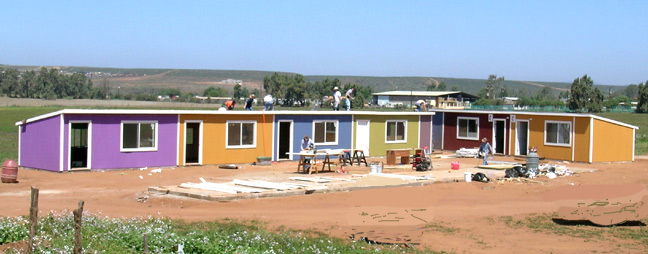
|
| Fourplex on the left, duplex on the right. |
Seventy Volunteers Construct Six Homes in Colonet
More
than 70 volunteers from a half-dozen churches in the California-Nevada Conference spent their Easter Break in Baja California
this April, constructing six homes for residents in the agricultural village of Colonet.
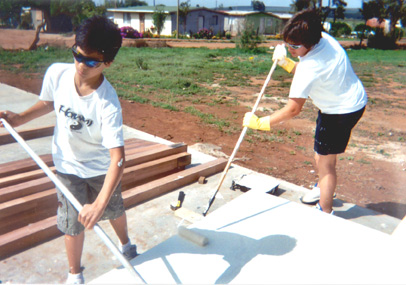
|
| Painting Roof Sheathing |
It was the largest project in a
three-year program in which conference volunteers have constructed a total of 18 homes and community buildings for residents
of this small town 150 miles south of San Diego. One group of 30 was organized
by Shasta District Lay Leader David Haynes of Trinity UMC in Chico. His group
built two houses in the week before Easter. They were followed a few days later
by 40 volunteers, most of them from Los Gatos UMC. This contingent was assembled by Los Gatos members Dave Wolf and Karen
Noe and constructed a fourplex.
The
six homes constructed in April are part of an eventual 10-unit complex on land that was donated by a local grower, Sergio
Saucedo.
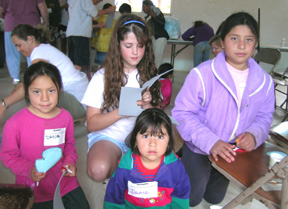
|
| Vacation Bible School at Iglesia Metodista |
Both of the groups included equal mixes of adults and youth, most of them teen-agers.
Volunteers had ample opportunity to mix with the residents of Colonet. When
they weren’t painting or hammering, younger members of the Chico group spent many hours playing soccer and baseball
with local youngsters in a field adjacent to the construction site. The Los Gatos
volunteers ran a two-day Vacation Bible School at the local Methodist Church, and also joined members of that congregation
during Easter morning worship services. Los Gatos volunteers were able to find time to give the church's Sunday School
a fresh coat of bright lavender paint. (See picture at bottom of story).

|
| Kenny and the roof crew |
“This was an excellent week
for all of the kids,” said Los Gatos organizer Karen Noe. “Most of
the experienced adults worked hard to involve the youngsters in the project, and they have gained a lot of skills in many
areas, including plumbing, electrical and roofing.”
The
six houses are intended for senior citizens, most of whom will be former agricultural workers who have settled in
Colonet. Each of the homes is of
wooden frame construction, with plywood siding on the exterior and OSB (oriented strand board) on the interior. The shed roofs include 2 x 6 rafters on 24” centers, OSB sheathing, and composition shingles. All of the homes have been wired for electricity, although not all residents can afford
to have it connected. Houses are constructed on concrete slabs that
are poured several months in advance of the home construction.
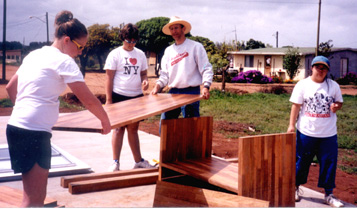
|
| Assembling counters for the kitchens |
Each home contains a large
counter and sink for food preparation. Two toilets and a shower are included
at the ends of both the duplex and fourplex, although it may be a year or more before the local water system reaches the newly
constructed buildings. The toilets and shower also will require construction
of a septic system, a project usually undertaken by the residents themselves.
On
previous trips, volunteers have constructed single dwellings, but future groups likely will concentrate on multiple units
such as duplexes and four-plexes. The Chico group was able to complete its duplex
in four days, while the Los Gatos group was able to finish the four-plex in about five days.
“The goal is to put as many roofs over as many heads as possible,” explained David Haynes. “If we can build two attached homes in about the same time as a single house, why not?”
Despite
enormous increases in the cost of building materials, each individual 12’ x 20’ home can be constructed for a
total cost of about $2500.
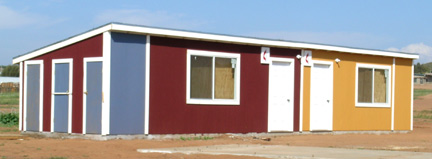
|
| The Duplex--Two of the eventual 10 units in the complex |
Although the future focus
will be on multiple dwellings, smaller groups still will build occasional individual homes, starting with a team from Foothills
UMC in June. They will construct a home for a mother with two children on a hill
overlooking Mexican Highway One during the week of June 12-17.
Although all of the homes thus far have been constructed by Methodist groups, the project
has also attracted the attention of Rotarians, both in the U.S. and Baja. Rotary
member Vic Baldridge of San Rafael is assembling a team that will consist of both Rotary members and Methodists that will
return to Colonet in August and build the fourplex that will complete the 10-unit complex started in April. That team will begin work on Saturday, July 31 and hopes to be finished by Wednesday, August 4.
Several members of previous teams are willing to give presentations to any church or civic
group interested in undertaking a mission. Those wishing more information should
contact Jim Horne at 1-800-327-1961.
Additional Testimonial From John Loofbourow at:
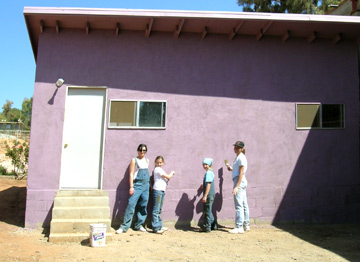
|
| The newly painted Sunday School at the Iglesia Metodista |
Volunteers Prepare for April VIM Projects
More than 60 volunteers are expected to travel to Colonet in mid-April
to construct six houses in the next phase in the California-Nevada Conference’s Mexico housing project. A group headed by David Haynes of Trinity Chico will be building two houses in the week before Easter (April
3-9), and a second contingent organized by Dave Wolf and Karen Noe of Las Gatos UMC will construct a fourplex during the week
after Easter (April 10-16). Previous groups have constructed a total of nine houses and three community buildings since
the UMC initiated the current program three years ago.

|
| Proposed Colonet Four-plex |
The April projects represent a significant departure from previous
efforts when groups traveled to Mexico to build a single house in three or four days.
Now groups will be staying five or six days and will be constructing multiple-unit structures. The Chico group will erect a 12’ x 44’ building that will contain two 12’ x 20’
homes, along with a set of toilets and shower that will be shared by residents. The
Los Gatos volunteers will build a 12’ x 84’ structure that will contain four 12’ x 20’ units and another
set of toilets and shower.
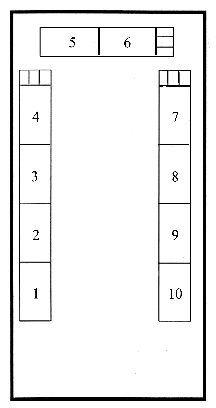
A major impetus to the program has been provided by local grower
Sergio Saucedo whose company, Ejido Agricola, is donating about one-quarter of an acre for this next series of buildings. In addition to the two buildings planned for April, a third four-plex will be constructed
later in the year, bringing the total number of homes on the parcel to ten. The
units will be placed in a U-shaped configuration, allowing for a central court that can be used for a community garden or
children’s play area.
The land is located about three blocks west of Mexican Highway One at the edge of a huge open
area that separates central Colonet from the less developed area that has been populated by many residents who have emigrated
from the predominantly Indian areas in southern Mexico. The huge parcel of vacant
land is owned by local growers and has been proposed as the site for a new high school and park, among other possible uses. The growers have indicated that additional land in this area might be available for
future VIM housing projects.
As might be imagined, facilitator Frances Jackson is ecstatic about the new project, as she has a number of older residents
who are in desperate need of housing. Accordingly, the first six units likely
will be designed for older residents (in other words, they will not include lofts).
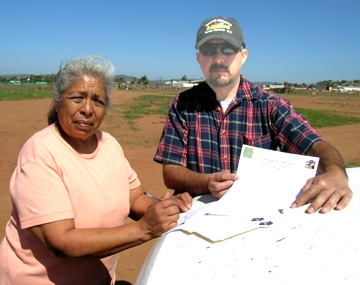
|
| Frances and Sergio--Signing the Papers |
Considerable discussion has preceded the plans to use this
land, as Frances wanted to receive assurances from the donor that the residents would be guaranteed the right to live in the
homes for the remainder of their lives. Accordingly, the donating growers will
be registering papers with the local town offices (that is, the Delegado) that will provide residents with the legal right
to remain in their homes until they die. After that, the homes will be available
for the placement of successor tenants.
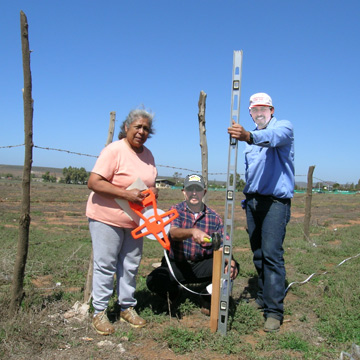
|
| Setting the Stakes for the First Four-Plex |
An initial agreement has been prepared to this effect, and more formal documents for each individual dwelling will be registered
after the homes are completed. Following signing of the initial document on Saturday,
March 6, a crew of volunteers (including Sergio Saucedo, Frances, and Ivan Oretega Rubio)
began staking out the sites for the initial six dwelling units.
Before Ivan, our cement specialist, starts work on the slabs, the town
surveyor (probably the Delegado himself!) has to indicate the location of a new north-south road which will run along the
western border of the project and eventually will provide an additional connection between the two sections of Colonet (which
are now joined only by Mexican Highway One)
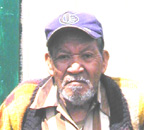
|
| David (1912-2004) |
Although the pace of life in Colonet does not seem to change dramatically from year to
year, there have been a number of developments in the past six months. Among
them are the unfortunate deaths of three of the beneficiaries of previous projects, including 92-year-old David Molina Hernandez
who was the owner of Casa II. In addition, Frances has passed along
news of the death of the husband of Ruffina Ramirez, the 86-year-old great-grandmother who received a new roof last September
for her home that is located midway between Colonet and the Sonora Hilton. Earlier,
we were told of the death of Candalerio Martinez Armas, the handicapped gentleman for whom Casa IV was constructed.
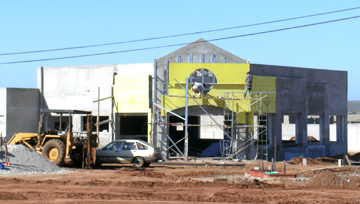
|
| Pemex Station under construction |
There is happier news. A major addition to the scene in Colonet is a new PEMEX
station which is nearing completion! (For newcomers, PEMEX is the state-operated petroleum
company that is the sole distributor of fuel in Mexico). This is located near the center of town and will be
of considerable value, as it will eliminate the 15-mile round trips to the station located nearly eight miles south of town. In another curious development, town officials have started erecting street signs….but
only in the aforementioned less prosperous Indian community south of city center.
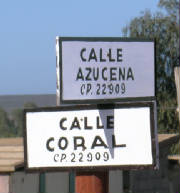
During April’s construction projects, a number of volunteers
will be engaged in other community efforts, including a number of jobs at the local Iglesia Metodista. The local pastors (Jose Gomez and wife Gabriela) have asked for help in a number of areas, including the
possibility of having a Vacation Bible School in one or both weeks. This would
be an extremely valuable opportunity for the Estados Unidos youth to interact with some of the kids in the community we are
serving! Other requests from Jose and Gabriela:
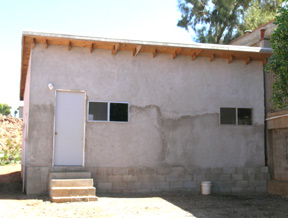
1. Painting of Sunday School. At
least three separate West Coast VIM teams (including one organized from the Shasta District) have participated in the construction
of a Sunday School building next to the church. On a subsequent mission, Los Gatos UMC provided funds for the stuccoing
of the building’s cinder block exterior, and the Sunday School is finally ready for a coat of paint. The pastor has also asked if this group could install a door knob on the building (it currently has only
a key-operated dead bolt).
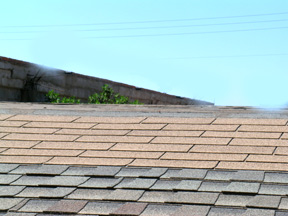
2. Final shingling of roof. The
previous teams apparently ran out of shingles when they were working on the roof. The
pastor has requested enough shingles to finish the job. (This should not be a
problem since there are several hundred extra shingles in the VIM storage unit in Colonet, and both of the two groups working
in April will include some of the Conference’s most highly skilled roofing specialists).
As you can see from the picture, the color of the final two rows of shingles will not be an issue!
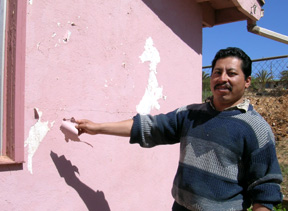
3. Painting of parsonage/church.
A VIM team painted the parsonage in January, 2000, but the paint has never properly adhered to the stucco. Painting guru David Haynes (leader of the Chico group) will attempt to obtain a sealant that will permit
latex exterior paint to stick to the stucco surface. With a large number of painters
signed up for the two April missions, the thought is that they can undertake this job during one of the slow periods at the
housing construction site. (Slow periods?)
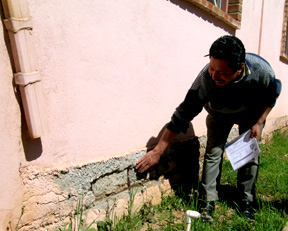
4. Cement repairs at base of church/parsonage.
A longer term project would involve reinforcement of the foundation of the main building which is showing signs of
deterioration. While this particular project probably will not be completed during
the April trips, hopefully some of the cement/masonry specialists can devise a possible solution to the problem. (It may be as simple as mixing and pouring an additional short wall around the affected areas….which
could be undertaken by Ivan if he were provided the cement and gravel).
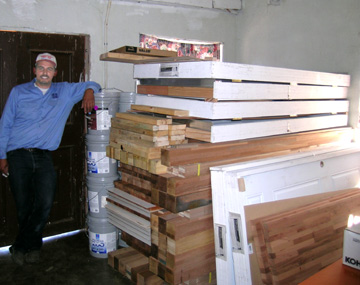
|
| Ivan with accumulated materials |
Other administrative details for the trips to come:
1. Materials Needed. Most of the doors, headers, toilets,
kitchen counters and paint have already been delivered to Colonet and are now being stored in Frances’ kitchen at the
elementary school. However, additional items are needed, including six identical
72” x 48” windows (to be provided by Vic Baldridge), at least 50 gallons of interior paint (white or something
close to it), and six stainless steel sinks. Contributors/providers will be held
in high esteem, of course.
2. Housing Possibilities. A total of 14 rooms have been reserved
at the Sonora Hilton for the Chico group, and all 17 rooms have been requested for the Los Gatos contingent. The Iglesia Sunday School also will be available, and the overflow (if any) can be handled at the Senior
Center or the Kitchen.
3. Food. As in the past, Frances will be providing dinner each
night in the school kitchen. As on previous trips, if we provide the vittles,
she does the cookin’. Both groups should make plans to purchase food in
the U.S. before crossing the border…..in the past this usually has been chicken, ground beef, cheese and large quantities
of lettuce. However, there are no limitations in this area….and other food
stuffs (such as tender steaks, honey-baked hams, and similar staples) would probably be greeted with favor. In view of the enormous burden we are placing on Frances for two weeks, it is important that we NOT involve
her or the kitchen for breakfasts and lunches. (In this regard, it must
be appreciated that Frances has lost Elsa, her niece and principal helpmate. Elsa
Sifuentes and her family were forced to relocate to Tijuana in order to permit her husband (Gustavo) to find a suitable job
in the U.S.)
4. Power. There will not be any electricity proximate to the
building site, and we will need at least one more generator from each group.
5. Lessons learned. Apparently the Mexican officials are now
being a bit more aggressive in collecting duty…..and on a recent trip, we were forced to pay a whopping $51 in order
to import six toilets purchased in the U.S. The great irony is that these toilets
were MANUFACTURED IN MEXICO. What ever happened to NAFTA?? We have a suggested strategy for avoiding this situation that we will not post on the public internet,
but would be happy to share off line.
Lesson #2. It is illegal to pass another vehicle over a single, solid line. (You can pass only in those rare areas where the line is broken).
This is probably the most ignored law in Mexico, but it still yields occasional revenue to support the local constabulary
in a suitable manner. When stopped, the procedure involves the patrolman confiscating
the offender’s license…..and a court appearance in Ensenada at which the fine is paid and the license is retrieved. Most motorists would find this inconvenient, so the traffic patrolman suggests the
alternative of an instant fine. (Only $21, and it is best NOT to ask for a receipt).
Summary of Colonet Mission
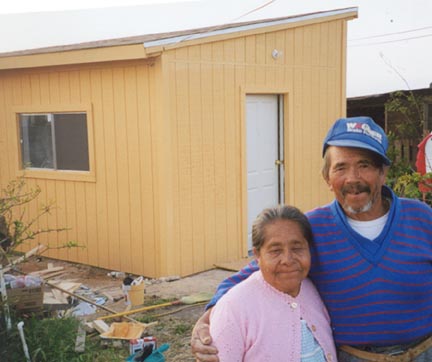
|
| Nico and Maximina--Homeowners of Casa I |
Perfect Plank Co. is a major supporter of the United Methodist
Church's home-building program in Colonet, Mexico (a small agricultural community located 150 miles south of Tijuana). Since
January, 2001, volunteers have constructed nine homes and three community buildings in the town.
The most recent
construction efforts were a senior center/homeless shelter which was built next to Colonet's municipal building in April,
2003, two houses which were constructed by a large group of 35 volunteers (including 15 youth) in May 2003, a kindergarten
which was constructed in July, 2003 for Indian children living in the highlands east of the town, and another house built
during the last week of September, 2003.
In mid-August a group of youth from Alaska and Washington State traveled to
Colonet to paint the kindergarten and to varnish tables and benches which will be used in that classroom as well as in the
Sunday School of the local Iglesia Metodista (Methodist Church).
The new kindergarten is located in a desolate area
about a quarter-mile east of Highway One. It is situated about mid-way between two neighborhoods populated by a number of
young children who are unable to make their way to the more distant schools...particularly since that involves the daunting
prospect of crossing the main highway. It will be a long walk for some of these kids, but it definitely won't involve dealing
with any traffic. Now that the school is built, the Mexican authorities have promised to provide a teacher for the start of
school this fall. Unfortunately the first teacher was involved in an accident before she could start her duties, so the local
parents are now appealing to authorities in Ensenada for appointment of another teacher.
In addition to sending youth
to work on site, members of the church in Alaska which sponsored the youth mission have donated $500 for additional books
and supplies for the kindergarten!
In other developments, the Iglesia Metodista now has its first in-resident pastor
in many years! The new pastor is Jose Gomez. His wife is Gabriela and they have two children, Josue (7) and Anna (4)....all
of whom are living in the parsonage behind the church. Hopefully, an in-resident pastor will make it possible for the church
to be more effective in its service to the community.
THe other major changes in Colonet involve the Migrant (Indian)
School on the South Side of Colonet. This is the institution for which volunteers built a kitchen and constructed a new roof
over one of the classrooms in the summer of 2002.
Since then, the Migrant School has undergone dramatic changes--two
new classrooms, a new full-size basketball court and a new pre-school building. In addition, the school has been completely
painted, and a number of improvements have been made, even including the planting of colorful flowers around the main building.
The goal is to encourage other churches and organizations to become involved in the Colonet
effort. Hopefully, there are many other congregations and groups who will see the benefit of sponsoring and participating
in one of these construction efforts. A group of only five volunteers can build a completed house in less than four days at
a cost of only $2000!
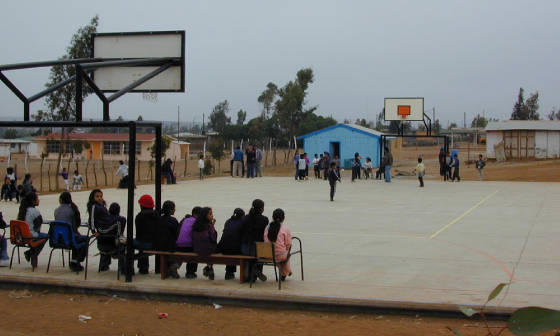
|
| The new basketball court at the Indian School (with the blue kitchen in the background) |
Report of Mission XII--September, 2003
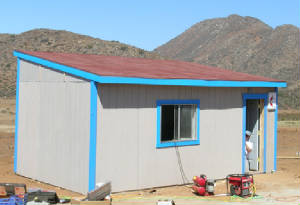
|
| CASA XII |
On the latest trip to Colonet (September 29-October 3), a group of 13 volunteers
was able to complete Casa XII as well as construct a new roof for 84-year-old Ruffina Ramirez.
It was a rather different experience than any previous trip, as Casa XII was constructed in a remote farming area,
about 10 miles north of Colonet and 6 ½ miles off Mexican Highway One.
CASA XII is a conventional home (with loft) to serve Martin Villa Fuertes,
his wife Gelina Morales and their children, Jorge 8 and Guadalupe 5. (Martin's job is to move the irrigation pipes in
the many acres of fields which surround the home site. He and his family formerly were living in a blue school bus with attached
lean-to).
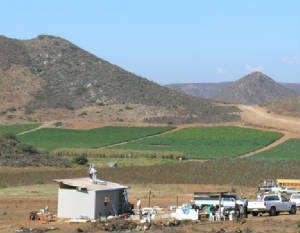
|
| Casa XII With Tomato and Pepper fields in background |
Reaching the job site gave everyone a chance to get a close look at the sort of farming
that is now the norm in the modern, globalized economy—huge fields of tomatoes, peppers, cucumbers and squash as far
as you could see in many directions. Particularly tomatoes! And each trip back and forth to the job site was an adventure in itself, as the narrow dirt road was a
veritable expressway for huge vegetable trucks and school buses (transporting workers to and from the fields).
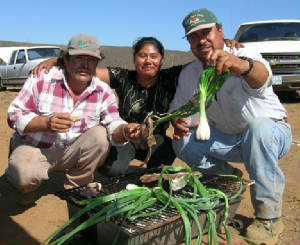
|
| Martin and Angie and Gabriel (the boss!) |
As noted, Casa XII was constructed for Martin Villa Fuertes and his family. He is a key employee on a 500-acre tomato farm that surrounds the lot on which his
new home sits. He and his wife were active participants in the construction,
doing a fair amount of painting as well as keeping the crew well fed during their four days on the job site. Much to our surprise, his very kind and enterprising ‘boss’ —the owner of the 500-acre
farm (and also Gelina's Godfather!)-- spent several days at the job site, helping to prepare lunches on two days.

While Casa XII was under construction, three members of the 13-person crew were
busy constructing a new roof for the home of 84-year-old Ruffina Ramirez who lives just off Highway One, about midway between
Colonet and the Sonora Hilton. As the pictures will suggest, this
is a rather imposing structure—both in terms of its mass and its rather distinctive bright blue color. A fine addition to the Mexican landscape!
Other highlights of the mission:
--Hans and Anna Marie Wiggers delivered a new automobile to Frances that was donated by Chris Munson of Los Gatos.
She was quite delighted and is eager to learn the ins and outs of operating a car with manual transmission. In addition
to the car, Hans and Anna-Marie delivered a computer (also donation by Chris) for the daughter (Cecilia) and niece (Paolo)
who are now in the 7th grade and eager to join the IT age.
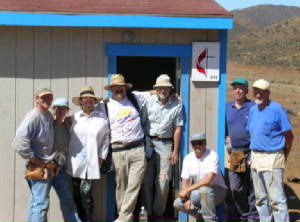
|
| Mission XII Crew |
--Frances served the usual fine assortment of meals, including succulent
Chile Reyenos (spelling doubtful), barbecued chicken and other delicacies. Even
a fine apple pie!
--On a sad note, Frances told us of the death of Candalero Martinez Armas, the 56-year-old handicapped gentlemen for
whom Casa IV was built in April, 2002.
Other plans for the
future:
--The proposed trip for Thanksgiving week has been postponed until spring.
--Fairfield UMC and Sonoma UMC are considering trips for 2003.
--Los Gatos UMC and Chico Trinity UMC are planning trips for their youth during Easter Vacation next spring.
--We are again contemplating a run to Colonet in early December in which
we would transport presents for the children of the community. The local Iglesia
Metodista (now with a new pastor) holds an annual Christmas party for the town,
and if our conference churches collect the presents we will make certain that they are delivered in time for Christmas.
--A Rotary Club in Marin is working with the Rotary Club in San Quintin (of which Frances is a member) to determine
the feasibility of undertaking a home construction project in the spring.
|

